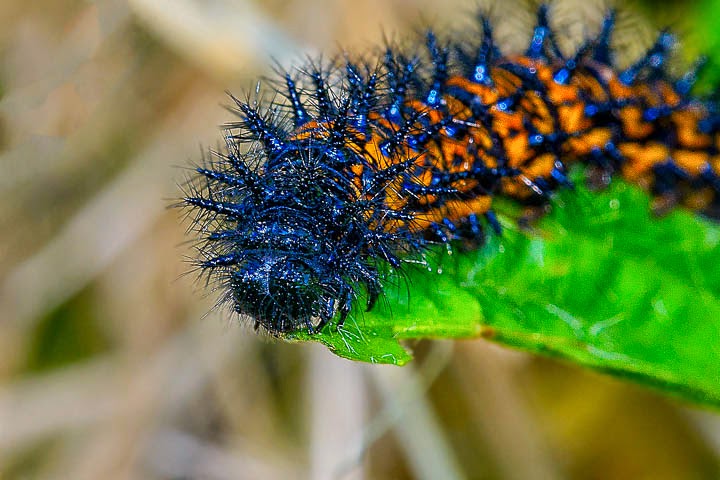 |
| Baltimore Checkerspot |
 |
| Baltimore Checkerspot Caterpillar Environmental Photo |
 |
| Baltimore Checkerspot Caterpillar Feeding on Plant Leaf |
 |
| Baltimore Checkerspot Caterpillar in the Morning Dew |
Once the caterpillars reach full size, they will form a chrysalis in which they will transform into an adult. This stage usually takes approximately 2 weeks.
 |
| Baltimore Checkerspot Chrysalis |
At Allens pond the butterflies will emerge in early July and their flight lasts approximately 2 weeks.
 |
| Baltimore Checkerspot Feeding on Thistle |
The Baltimore Checkerspot was named for the first Lord Baltimore, George Calvert, because it's colors of orange and black with the same colors that were on Lord Baltimore's heraldic shield. The Baltimore checkerspot in 1973 was named the official insect of Maryland.
Baltimore checkerspot's range from southern Manitoba Eastern Nova Scotia itself to Nebraska Kansas and Georgia. In New England is found everywhere except northern Maine. They are found in meadows, both wet and dry and have scattered colonies throughout the state.
Baltimore checkerspots are members of the family Nymphalidae, the Brushfooted butterflies. The wingspan of the checkerspots is approximately 2 1/2 inches. The food of the caterpillars includes English Plantain , Common Plantain, Arrowwood, and False Foxglove. The adults will feed on mid-summer flowering species.
The lifecycle starts after the adults emerge and they mate with deposition of eggs on the underside of hosts plant leaves. It takes approximately 20 days for the eggs to hatch. The little caterpillars will crawl to the top of the leaves and will live in a communal nest that they construct with silk. The caterpillars will stop eating and early autumn and then descend to the base of the food plants and overwinter in the leaf litter where they will emerge in the spring and start the cycle all over again.
For all my readers who use Topaz Detail They have put out an upgrade to Detail 3.2.0 with improved interface and technology It is a free download on the Topaz site. A recent webinar "The Perfect Program for Nature and Landscape Photography was recorded and the edited version will be available to review at youtube.com/topazlabs soon. If you do not have Detail use trhis topaz link http://www.topazlabs.com/850.html and use the code “mborn” for a 15% discount.
I utilize Topaz Detail and Clarity regularly
No comments:
Post a Comment